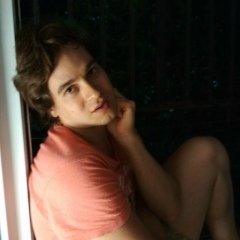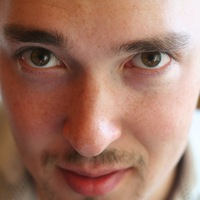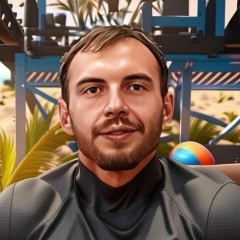Хихон, часть заключительная. Прощальный взгляд на город и римские бани.
В Хихоне есть музей - развалины римских бань, где можно разглядеть все их устройство. Музей небольшой, но в принципе почему б было и не зайти.
Именно в этом музее я и разговорился по-русски с испанцем, пятнадцать лет проработавшем на пилораме под Днепропетровском, теперь он служащий этого музея. Если кто туда тоже зайдет - передавайте привет.
Ну и еще раз марина города Хихон - отличный пример как из унылого промышленного города можно сделать прекрасное место, где будут гулять люди и будет кипеть жизнь.
И напоследок на фоне Пелайо двое велосипедистов, один из которых через пару минут скажет "ничего себе, туристы в Хихоне". А дядька с большим рюкзаком на фоне - это с большой вероятностью паломник, идущий по пути Сантьяго.
Вот такая жизнь у города Хихон. В целом спокойная. Промышленность. Почти нет туристов. Народ в целом бодрый и оптимистичный. И неспешно бредущие паломники. И океан.
В кафе на центральной площади (справа от памятника Пелайо) есть англоязычное меню, но никто не говорит по-английски. Если учесть ритм жизни города, то это и не удивительно. Хотя сделать заказ в кафе по-испански я уже в состоянии.
Но вот слева от меня сидела пара в солидном возрасте из Италии. Правда, они свободно говорили с официантом по-испански.
Еще заметил, что никто не заказывал сидр. Удивительно, да. Все-таки самый региональный напиток какой есть. А никто не берет.
В Овьедо это только подтвердилось - такое впечатление что сидр и шоу с его разливанием - это больше для туристов (в Овьедо туристов уже достаточно), примерно как и игра на волынке в тех краях. Хотя ладно, один раз я видел местных, которые таки пили сидр - им для этого принесли специальное приспособление, с помощью которого сидр разливался сам с правильной высоты. Потому что его можно разливать только с высоты вытянутой вверх руки, иначе не комильфо.
В Хихоне есть музей - развалины римских бань, где можно разглядеть все их устройство. Музей небольшой, но в принципе почему б было и не зайти.
Именно в этом музее я и разговорился по-русски с испанцем, пятнадцать лет проработавшем на пилораме под Днепропетровском, теперь он служащий этого музея. Если кто туда тоже зайдет - передавайте привет.
Ну и еще раз марина города Хихон - отличный пример как из унылого промышленного города можно сделать прекрасное место, где будут гулять люди и будет кипеть жизнь.
И напоследок на фоне Пелайо двое велосипедистов, один из которых через пару минут скажет "ничего себе, туристы в Хихоне". А дядька с большим рюкзаком на фоне - это с большой вероятностью паломник, идущий по пути Сантьяго.
Вот такая жизнь у города Хихон. В целом спокойная. Промышленность. Почти нет туристов. Народ в целом бодрый и оптимистичный. И неспешно бредущие паломники. И океан.
В кафе на центральной площади (справа от памятника Пелайо) есть англоязычное меню, но никто не говорит по-английски. Если учесть ритм жизни города, то это и не удивительно. Хотя сделать заказ в кафе по-испански я уже в состоянии.
Но вот слева от меня сидела пара в солидном возрасте из Италии. Правда, они свободно говорили с официантом по-испански.
Еще заметил, что никто не заказывал сидр. Удивительно, да. Все-таки самый региональный напиток какой есть. А никто не берет.
В Овьедо это только подтвердилось - такое впечатление что сидр и шоу с его разливанием - это больше для туристов (в Овьедо туристов уже достаточно), примерно как и игра на волынке в тех краях. Хотя ладно, один раз я видел местных, которые таки пили сидр - им для этого принесли специальное приспособление, с помощью которого сидр разливался сам с правильной высоты. Потому что его можно разливать только с высоты вытянутой вверх руки, иначе не комильфо.
Gijon, part of the final. Farewell view of the city and the Roman baths.
In Gijon there is a museum - the ruins of the Roman baths, where you can see all their devices. The museum is small, but in principle, why it was used and not to go.
It was in this museum that I talked in Russian with a Spaniard who had worked for fifteen years at a sawmill near Dnepropetrovsk, now he is an employee of this museum. If someone goes there, say hello.
Well, once again the marina of the city of Gijon - a great example of how from a dull industrial city you can make a great place where people will walk and life will boil.
And finally, on the background of Pelayo, two cyclists, one of whom in a couple of minutes will say "wow, tourists in Gijon". And the guy with the big backpack on the background is most likely a pilgrim walking along the path of Santiago.
This is the life of the city of Gijon. Overall calm. Industry. Almost no tourists. The people as a whole are cheerful and optimistic. And slowly wandering pilgrims. And the ocean.
The cafe in the central square (to the right of the Pelayo monument) has an English-language menu, but no one speaks English. If we take into account the rhythm of the life of the city, this is not surprising. Although I am able to place an order in a cafe in Spanish.
But here to my left was a couple at a respectable age from Italy. True, they were fluent in Spanish with the waiter.
I also noticed that no one ordered cider. Amazing yes. Still, the most regional drink which is. And no one takes.
In Oviedo, this was only confirmed - the impression that cider and the show with its pouring are more for tourists (there are already enough tourists in Oviedo), something like playing the bagpipes in those parts. Although, okay, once I saw locals who did drink cider - they were given a special device for this, with which the cider was poured from the correct height. Because it can be poured only from the height of the arm extended upwards, otherwise not comme il faut.
In Gijon there is a museum - the ruins of the Roman baths, where you can see all their devices. The museum is small, but in principle, why it was used and not to go.
It was in this museum that I talked in Russian with a Spaniard who had worked for fifteen years at a sawmill near Dnepropetrovsk, now he is an employee of this museum. If someone goes there, say hello.
Well, once again the marina of the city of Gijon - a great example of how from a dull industrial city you can make a great place where people will walk and life will boil.
And finally, on the background of Pelayo, two cyclists, one of whom in a couple of minutes will say "wow, tourists in Gijon". And the guy with the big backpack on the background is most likely a pilgrim walking along the path of Santiago.
This is the life of the city of Gijon. Overall calm. Industry. Almost no tourists. The people as a whole are cheerful and optimistic. And slowly wandering pilgrims. And the ocean.
The cafe in the central square (to the right of the Pelayo monument) has an English-language menu, but no one speaks English. If we take into account the rhythm of the life of the city, this is not surprising. Although I am able to place an order in a cafe in Spanish.
But here to my left was a couple at a respectable age from Italy. True, they were fluent in Spanish with the waiter.
I also noticed that no one ordered cider. Amazing yes. Still, the most regional drink which is. And no one takes.
In Oviedo, this was only confirmed - the impression that cider and the show with its pouring are more for tourists (there are already enough tourists in Oviedo), something like playing the bagpipes in those parts. Although, okay, once I saw locals who did drink cider - they were given a special device for this, with which the cider was poured from the correct height. Because it can be poured only from the height of the arm extended upwards, otherwise not comme il faut.







У записи 1 лайков,
0 репостов,
74 просмотров.
0 репостов,
74 просмотров.
Эту запись оставил(а) на своей стене Антон Лобов






















